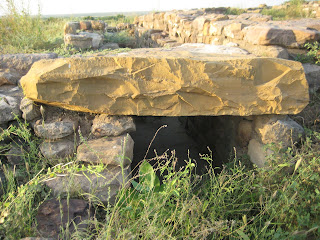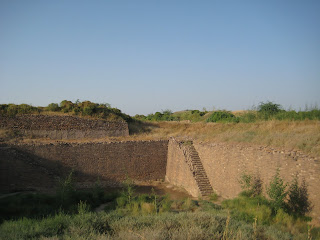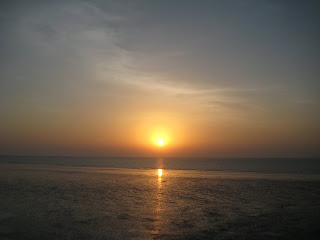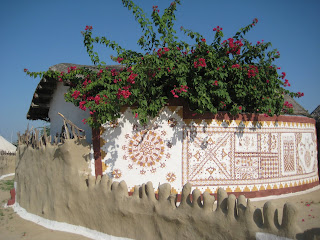We left Dhola Vira early the next day, heading to a small village where our entire busload had been invited for breakfast. People were curious and were speculating about the 'richest man in the village' who had asked us all for a meal. We drove into a modern and well laid out compound surrounded by fields. There seemed to be a large rest house for visitors on one side and another big building in the distance. A neatly dressed, soft spoken man welcomed us and led us in, conveying the good wishes of the host. Evidently the richest man was not to be met in person. The building, spotlessly clean had rows of rooms and attached bathrooms running along the corridor. Several of these on the top floor were opened up for us to use. Then came breakfast.
It was the most amazing meal we had eaten so far- traditional food at its best. Large, wafer thin rotis made of bajra (pearl millet), thin and long, fluffy sheets of fried besan (gram flour) which left not a trace of oil in the mouth, fresh green chilly pickle, a bowl of the staple kadhi made of sour curd and tempered with spices and a hint of sugar, a bowl of fresh curd and finally hot, sweet tea. People came by periodically, pressing us to eat more- and more...
Just before leaving, we thanked the people who had looked after us so graciously and I asked them what this place was. Uptil then, they had not said a word about themselves. The man in charge explained that it was actually a place for children whose growth was not quite normal, a sort of school and a refuge in a sense from the harsh, demanding 'normal' world, where these children could learn and grow in peace. It was said in a very gentle, matter of fact way and was a reminder to me that there is a place for everyone in this country of millions. Differences are not threatening in India as they often are in more homogeneous places; there are many pockets of humanism especially where saints and spiritual leaders have lived or preached. It is a nice feeling that, though often hidden from the public gaze, there is indeed a place where each of us might find comfort.
We proceeded to Bhuj, dropping off various groups along the way (people were divided into small parties depending on their next destination). After a large Gujarati thali meal in Bhuj, our small group of three friends along with a French archeologist, a Portuguese historian and a couple of guides, drove out, north by northwest - far into nowhere with nothing but the sun and the earth (and a monitor lizard and large black cobra that crossed the road). We crossed the tropic of cancer, the Frenchman sat back with an exaggerated sigh of relief, "Ah, but it iz cooler now!" and the irrepressible Portuguese added, " It says, 'the tropic of cancer passes here, but it doesn't say at what time.."
We drove on, stopping at a small village on the way, towards our destination - Hodko village, which we reached well after the sun had set.
Monday, October 25, 2010
Sunday, October 17, 2010
Dussera
Today is Dussera or Vijayadashami, the tenth and final day of the celebrations of the victory of good over evil. This is celebrated in very different ways in different parts of the country, with minor variations from house to house. We were fortunate to witness some very lovely celebrations in Bangalore with different families, beginning with the arranging of dolls in an ascending step-like formation by women in the house.
This has to do with a legend about how, when demons were ruling the earth, all the gods put their energies together in the form of Shakti (depicted by Durga) in order to kill them. The gods and goddesses stood still as statues and channelized their power to Durga- the fiery goddess whose moves on a lion and who destroyed the demon Mahishasura. This is symbolically recreated by the rows of dolls which are passed on from mother to daughter.
We were also invited to a traditional lunch - a gargantuan meal which we ate off banana leaves on the floor of our yoga classroom. Before this, many of the older (and a few younger) relatives got together and sang and chanted prayers, a culmination of nine days of singing. It was the first time we had heard an entire houseful of people singing together and it created a lovely melodious and informal atmosphere.
This is of course just the beginning of festivity- it leads on to Diwali or Deepavali, the festival of lights, next month.
| The Goddess of Learning (surrounded by books and implements) forms the base of the array of dolls |
We were also invited to a traditional lunch - a gargantuan meal which we ate off banana leaves on the floor of our yoga classroom. Before this, many of the older (and a few younger) relatives got together and sang and chanted prayers, a culmination of nine days of singing. It was the first time we had heard an entire houseful of people singing together and it created a lovely melodious and informal atmosphere.
| Food - ready to be served in small buckets |
| The beginning of a large meal... |
| The food ends but not the celebrations |
| Finally -the cooks eat |
Thursday, October 14, 2010
Dhola Vira - excerpts from my travelogue
An amazing day! Left the hotel at 6.30 a.m., managing to get a slice of bread and butter and a cup of tea at the tent. Had to make sure the cat and hopeful looking dog (and mouse) that were our tent companions did not get to the food before us. Reached the bus to find about 25 other hungry fellow creatures. The bus apparently did not stop for breakfast and so United Young Archeologists of India took over (whatever would we do without them?) Ensuring there was never a silent moment, they (under the aegis of Big Boss and Tomato Shirt- pardon the description but it's the best I could come up with) continually demanded (and occasionally got) aloo parantha (pan fried bread stuffed with potatoes) and tea and the rest of us seemed to have no option but to down it. A novel diet for our European historian friends (and for us as well). Our destination - Dhola Vira.

Dhola Vira is a small village in a corner of the Great Rann of Kachchh - far from everything else. It is one of the largest Indian excavations of cities belonging to the Indus Valley civilization and dates to about 2650 to 1450 B.C. It looked large - enormous in fact from the tiny window of our bus. The loud noise within the bus grew louder. Mme Archeologiste wanted everyone to leap out and start running about amidst the ruins (keep in mind that it was close to 40 degrees under the desert afternoon sun and the approximate passenger age was well above 60). Tomato shirt was yelling because the bus driver refused to stop for tea in the crowded bus station. Big Boss was wondering how we would manage without him tomorrow and was giving instructions to no one in particular. I was busy having a small migraine.
Anyway. We decided to go to the Archeology guest house first amidst much squabbling. Rooms were allotted amidst more squabbling. Dhola Vira is in the middle of nowhere and there is no other place to stay than the atmospheric circular-shaped single room cottages constructed by the Department of Archaeology a few kms from the site.
Eventually we all trooped out to the site and met our guide - Dr. Rawat, who had spent some years as a part of the excavation team. A wonderful, pragmatic individual who led us through the very well kept museum and showed us impressive artefacts of clay, metal and stone that had been unearthed from the site. We saw perfectly sculpted large clay jars, polished beads, beautiful clay models (toys?), gold and silver ornaments and exquisite seals. (UYAI ditched the museum, vanished into the field and I didn't miss them though they missed a good introduction and an interesting film on the excavations).
Dhola Vira is huge - about 100 hectares- and very impressive. The entire site comprises of a well planned fort-like area containing a fortified outer, lower town leading up to a second, further fortified middle town. There are large gates on each of the four sides. Further additions were made to the town at a later stage which are now called the Castle and the Bailey. The ruins reveal a beautifully planned city with extensive and very advanced water management systems - ways in which water could be drained from a rivulet that flowed close by and ways in which rain water could be stored without wasting a single drop. Stone reservoirs about 7 metres deep and 79 metres long were constructed of stone that was quarried and brought from distant hills. We saw a water tank with steps leading all the way down and also a well with an arrangement to channelize water to another storage tank. Channels and drains constructed of stone (many were covered by rectangular stone slabs) were used to supply water to the city and also perhaps to drain out sewage.


There was a kind of stadium - a huge perfectly flat arena with seats around it and also a large area which probably served as a burial ground. One of the gateways (the northern gate) also had a huge 'sign'- a large piece of wood in which were set ten large letters in gypsum. The script is not deciphered, the language unknown.
Dr. Rawat's eyes lit up as he described these structures and one could see that it had all been reconstructed perfectly in his mind and that he was not seeing the brick and stone remnants of today but the glorious city of thousands of years before - that rose to an amazing level of sophistication and then died out (perhaps due to many years of successive drought). He showed us signs of a gradually dying city that lay within those walls - the drying out of a tank where eventually children ended up playing, the desertion of the outer city and the re-use of stone from there for other purposes in people's houses and more - he wove a fascinating tale with a sad end.
Where did the people go? We don't know for sure. But they left a spectacular ghost-memory behind.

Dhola Vira is a small village in a corner of the Great Rann of Kachchh - far from everything else. It is one of the largest Indian excavations of cities belonging to the Indus Valley civilization and dates to about 2650 to 1450 B.C. It looked large - enormous in fact from the tiny window of our bus. The loud noise within the bus grew louder. Mme Archeologiste wanted everyone to leap out and start running about amidst the ruins (keep in mind that it was close to 40 degrees under the desert afternoon sun and the approximate passenger age was well above 60). Tomato shirt was yelling because the bus driver refused to stop for tea in the crowded bus station. Big Boss was wondering how we would manage without him tomorrow and was giving instructions to no one in particular. I was busy having a small migraine.
Anyway. We decided to go to the Archeology guest house first amidst much squabbling. Rooms were allotted amidst more squabbling. Dhola Vira is in the middle of nowhere and there is no other place to stay than the atmospheric circular-shaped single room cottages constructed by the Department of Archaeology a few kms from the site.
Eventually we all trooped out to the site and met our guide - Dr. Rawat, who had spent some years as a part of the excavation team. A wonderful, pragmatic individual who led us through the very well kept museum and showed us impressive artefacts of clay, metal and stone that had been unearthed from the site. We saw perfectly sculpted large clay jars, polished beads, beautiful clay models (toys?), gold and silver ornaments and exquisite seals. (UYAI ditched the museum, vanished into the field and I didn't miss them though they missed a good introduction and an interesting film on the excavations).
Dhola Vira is huge - about 100 hectares- and very impressive. The entire site comprises of a well planned fort-like area containing a fortified outer, lower town leading up to a second, further fortified middle town. There are large gates on each of the four sides. Further additions were made to the town at a later stage which are now called the Castle and the Bailey. The ruins reveal a beautifully planned city with extensive and very advanced water management systems - ways in which water could be drained from a rivulet that flowed close by and ways in which rain water could be stored without wasting a single drop. Stone reservoirs about 7 metres deep and 79 metres long were constructed of stone that was quarried and brought from distant hills. We saw a water tank with steps leading all the way down and also a well with an arrangement to channelize water to another storage tank. Channels and drains constructed of stone (many were covered by rectangular stone slabs) were used to supply water to the city and also perhaps to drain out sewage.
There was a kind of stadium - a huge perfectly flat arena with seats around it and also a large area which probably served as a burial ground. One of the gateways (the northern gate) also had a huge 'sign'- a large piece of wood in which were set ten large letters in gypsum. The script is not deciphered, the language unknown.
Dr. Rawat's eyes lit up as he described these structures and one could see that it had all been reconstructed perfectly in his mind and that he was not seeing the brick and stone remnants of today but the glorious city of thousands of years before - that rose to an amazing level of sophistication and then died out (perhaps due to many years of successive drought). He showed us signs of a gradually dying city that lay within those walls - the drying out of a tank where eventually children ended up playing, the desertion of the outer city and the re-use of stone from there for other purposes in people's houses and more - he wove a fascinating tale with a sad end.
Where did the people go? We don't know for sure. But they left a spectacular ghost-memory behind.
Tuesday, October 12, 2010
Mandvi
Mandvi, an important port in Kachchh, is an old centre of boat building. Wooden boats are still built in traditional styles for customers in the gulf. Traditionally, Kachchhi sailors would use these boats to sail to Africa, carrying spices, coconuts, gold, silver and at times even cattle. They would wait there until the winds changed direction and then return to India.
The royal family still retains its palace and private beach (stated to be the only private beach in the country). They have converted a part of it into a hotel, with luxury tents that perch at the edge of the beach. The beach itself is long, flat and shallow for at least half a kilometre into the sea. The sand is dark and soft and the water during most times (except the monsoons) is tranquil. It was appealing not just to us, but to a number of birds and to the stray camel as well!
(Pictures courtesy M.S. Madhusudan)
Monday, October 11, 2010
Westward ho!
An exciting adventure, travelling to the westmost tip of India. We leave Bangalore aiport in the morning and fly to Bhuj via Mumbai. The most endearing thing about Bangalore airport is the flock of sparrows which has made its home there. They fly about unafraid, twittering and chirping and pecking at crumbs strewn around the restaurants.
We reach Bhuj in the afternoon and drive to Mandvi, about an hour away and close to the sea. This is the venue of the conference 'Gujarat and the Sea'- an overview of Gujarat's historic maritime links and tradition, an initiative of the Darshak Itihas Nidhi. A diverse and highly qualified set of people have arrived, including Indian and European scholars- historian, archeologists, underwater archaeologists and experienced seafarers - both European and Gujarati, and they meet and discuss traditional methods of navigation. Sarah Bancroft, using material from British archives, sets up an intriguing exhibition.
Late in the evening we go to our hotel, where we leave our bags in super tents on the picturesque beach of the Mandavi Palace. We rush out to get our first glimpse of the sea.
Dinner and traditional music is organised on the beach. The night sky is clear and we watch the seafarers demonstrate calculations of direction using the stars and simple, hand made instruments. It is a calm and beautiful spot, both in the evening and in the morning - when the only thing we see is a passing fisherman's boat. Couldn't be more apt!
Saturday, October 9, 2010
Visiting Kachchh
I just returned from a wonderful trip to the western most tip of India, Kachchh, now a part of the state of Gujarat. Kachchh means land that gets intermittently wet and dry (and is also the root for the word tortoise in Sanskrit) and here are found wet lands in the rainy season that dry up once the rains are over each year. The area, though a part of Gujarat, retains its cultural and historical identity and its ties to the neighbouring regions of Rajasthan and Sindh in Pakistan are still evident. Kachchh is bounded by the Gulf of Katchchh and the Arabian Sea on the west. The Great Rann of Kachchh, a part of the Thar desert, and the Little Rann of Kachchh (Rann means saltmarsh) form the northern and eastern parts of the district and the Banni grasslands lie in the south, forming a unique ecosystem.
I was visiting to attend a conference on the maritime history of Gujarat, titled Gujarat and the Sea - the first of its kind, to be organized in Mandvi, which served as a major port for this region. In addition, the organizers arranged for groups to travel and visit different regions of Kachchh, which are quite remote and hard to access. I plan to write a brief account of each of the five days that I spent there, but I begin with a few pictures that capture the overall spirit of the region.





I was visiting to attend a conference on the maritime history of Gujarat, titled Gujarat and the Sea - the first of its kind, to be organized in Mandvi, which served as a major port for this region. In addition, the organizers arranged for groups to travel and visit different regions of Kachchh, which are quite remote and hard to access. I plan to write a brief account of each of the five days that I spent there, but I begin with a few pictures that capture the overall spirit of the region.

Subscribe to:
Posts (Atom)